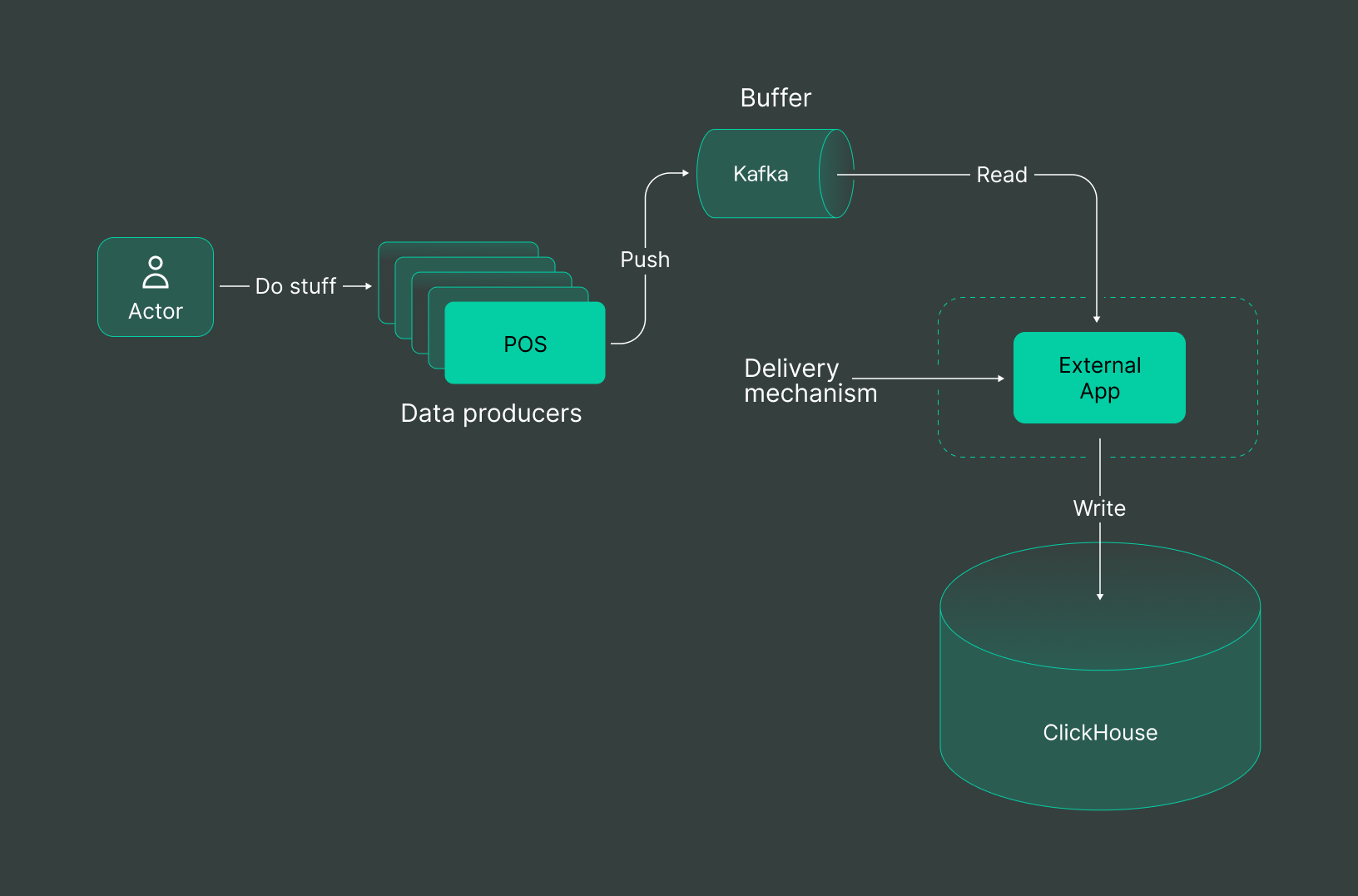Key Fact:
Do you know what irks the most PaaS users?
It’s maintaining a balance between newly adopted PaaS and in-use tools. Services like DoubleCloud Transfer can greatly help to bring everything to a centralized place.
📢 The Rockset ride is over; ClickHouse takes it further | Switch now, and we’ll help you migrate smoothly Learn more →

Cloud computing is at its all-time high with most global organizations using at least a minimum of one cloud ecosystem.
Cloud computing has three service models: SaaS, IaaS, and PaaS.
SaaS (Software-as-a-service) is fairly straightforward and we recently wrote about IaaS (here >>) but PaaS… the most influential and efficient cloud service mode…l can cause a bit more confusion sometimes.
PaaS stands for Platform-as-a-Service.
Individuals or organizations can access essential application development and management resources on the cloud through any implementer of this model, i.e., a PaaS platform/provider.
The list of these resources may include application development software, hardware, tools, storage, OS, and infrastructure.
With PaaS, developers or businesses don’t have to get involved in setting up and installing all these key resources. They can simply log in to those resources and use them according to the requirements.
For customers, the service provider takes care of the through-and-through management of cloud computing resources at monthly or yearly expenses that customers can pay per use.
The Platform-as-a-Service model follows a standard workflow for service delivery. It’s main three components are…
A well-formed cloud ecosystem featuring resources like firewalls, VMs, OS, storage, and networking;
Application development software that takes care of code building, deployment, and management;
A user-friendly GUI or Graphical User Interface for application developers or DevOps team to manage and deploy the lifecycle.
All the key tools and technologies are accessed by GUI that can be accessed from anywhere. Application development takes place with the help of PaaS-based middleware. The streamlined use of leads to simultaneous project development.
The launch of PaaS was a game changer in the world of cloud computing.
Before its inception, IT infrastructure was solely based on licensed-based products. That way, management of those resources tended to be very tedious and time-consuming.
The technology’s first public performance happened in 2006 as Zimki at the hands of Fotango. The official development was completed in 2005, but the beta version was launched at EuroOSCON one year later.
Zimki, being the very first platform tool version, featured both pros and cons.
For instance, it featured multiple developer accounts. But all of them were based on a single provider.
Earlier, Zimki was an open-source tool and later became a paid tool.
The prime aim of this early version was to eliminate the hurdles involved in code writing by handing over this job to the Platform as a Service provider. Only public cloud deployment was considered as PaaS deployment.
However, with time, businesses understood that the public cloud wasn’t enough to cater to their diverse needs.
This laid the foundation for private and hybrid cloud development. At the time of writing, the public PaaS cloud market stood at the mark of US$110 billion.
As customers demand continuous growth, the technology adopts new trends and progresses.

Key Fact:
Do you know what irks the most PaaS users?
It’s maintaining a balance between newly adopted PaaS and in-use tools. Services like DoubleCloud Transfer can greatly help to bring everything to a centralized place.
As mentioned above, for a long time, a public Platform-as-a-Service was the only offering. However, matured requirements quickly demanded other PaaS types:
This version is open-source and is accessible without any subscription cost.
The foundation of public PaaS is public SaaS. Its deployment is based on SaaS and IaaS. For instance, unlike SaaS, PaaS doesn’t consume the user-side hard-drive space.
Like IaaS, Platform-as-a-Service frees end-users from the hassle of server management, but a bit differently.
In IaaS, virtual hardware is offered. But, PaaS involves server providers by the hand of the service provider.
With Platform-as-a-Service, cloud computing users have the ability to have a personalized and private PaaS that is often deployed on-premise and in proprietary data centers.
Generally, private solutions are based on a unified hosting platform. It involves software deployment that happens on more than one machine.
Is the amalgamation of private and public Platform-as-a-service. Few resources will be open-source, while few will be 100% customized and on-premise.
cPaaS involves multiple cloud-based tools enabling real-time communication. Generally, video, voice, and messaging capabilities are its part.
Users don’t have to get involved in this back-end configuration and interface configuration.
Both hardware and software tools are part of cPaaS and are best known for features like less latency, jitter, and packet loss. The solution is mostly used to host cellular networks and PBX, which are crucial for real-time communication.
It was invented in 2012 and involves multiple development resources, and mobile application developers and designers can use it without any setup.
It’s a hosting-free option offering multiple open-source software that Platform-as-a-service providers deploy to run an app/tool on the cloud, Google App Engine is a suitable example of this category.
The surge in demand for AI caused the inception of AIPaaS. It provides a wide range of pre-built AI resources that people can use for various purposes. Generally, deep learning models and machine learning resources are hosted on it.
One can use AIPaaS as-it-is or can customize it according to need. These resources can further be used for the development of multiple AI tools.
This is a cloud-based PaaS that help businesses to integrate applications easily.
It simplifies how you connect with the processes, services, and data spread across all kinds of your cloud ecosystems. While this happens, iPaaS ensures that users don’t have to be extensively involved in software, hardware, and middleware management.
The simplest explanation behind the huge popularity of this service model is the wide range of benefits that this service brings to the table. The right implementation of the right kind of Platform-as-a-service tool enables businesses to relish the benefits like:
If an organization is extensively involved in application development then PaaS adoption can keep code development on the lower side.
The service model mostly provides fully integrated and pre-codes resources that hardly require coding.
The pre-built tools and resources of PaaS integrate automation at the core. The automated deployment, cloud data analysis, and maintenance capabilities enable a business to improve the time-to-market and shrink the development lifecycle.
PaaS is designed to boost productivity by permitting development on multiple devices at a time. You can develop on the web browser, mobile devices, desktop, and other platforms simultaneously. The direct result of this is quick development time.
PaaS is famous for its resource abundance.
The pay-per-use model offers a wide range of application development tools and resources like servers, networks, databases, OS, storage, VMs, and many more.
This great offering enables businesses of all sorts to engage in development even when no dedicated resources are there.
If you have a distributed and remote team, Platform-as-a-Service is an ideal choice to make as it’s easily accessible.
Your distributed team can assess required resources over a single click. This eliminates the odds of operational flaws that can take place due to miscommunication of disintegrated teams.
An application has to pass through multiple stages before come-up as a fully developed resource. All these stages are defined as SDLC, and its effective management is the key to success in application development.
By offering pre-vetted and fully-optimized resources, Platform-as-a-service allows developers to test, deploy, update, and manage the entire SDLC without any hassles.
Businesses using API extensively must adopt PaaS as its in-built frameworks ensure that API development, integration, and management are fully automated. It has capabilities that API users can use for sharing API capabilities in real-time.
IoT, or the Internet of Things, is one of the most recent technologies businesses leverage to improve productivity and workflow. IoT tool development is easy, swift, and error-free with PaaS, as it supports all the leading programming languages and frameworks.
Developers can design IoT tools and technologies of all sorts without much hassles and configuration.
If you’re using agile development of DevOps, then PaaS adoption is a great way to automate the entire SDLC. Starting from integration to testing, PaaS brings seamlessness into DevOps.
Those who’re involved in cloud migration and development must adopt PaaS to simplify the entire process. Replatforming, refactoring, and load balancing are a few features that the service model offers to ease cloud migration. As it adopts containers and microservices, things are easier than before.
Hybrid cloud brings the best of two worlds, private and public cloud, and its adoption rate is on the rise. PaaS will help you have a sound and effective hybrid cloud strategy as it enables businesses to develop resources once and reuse them in the hybrid cloud ecosystem.
PaaS is a great choice to make if you want to adopt the best security and compliance practices. Automatically deploys security monitoring practices based on machine learning and threat intelligence. With in-built access and identity management, improved security is a sure thing.
The PaaS adoption curve is only moving upwards, and the industry’s positive outlook indicates no slow-down anytime soon. As the cloud service model continues to evolve, new trends and technologies will likely show up.
The recent PaaS industry trends highlight flexible adoption that can support the remote work model. New architectures are showing up so that cloud, database, and security can integrate in a manner that remote work is less risky.
We might witness integration expansion in PaaS so that more and more 3rd party tools can be part of the workflow. Surged demands for managed PaaS services will increase as businesses look for fully optimized solutions that are bound to deliver quality results.
Even though the technology supports IoT, AI, and blockchain, native support is still lacking. We might enjoy native Platform as a Service support for all these and many other budding mission-critical technologies in the future.

A cloud agnostic service for aggregating, collecting, and migrating data from various sources.
